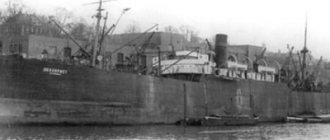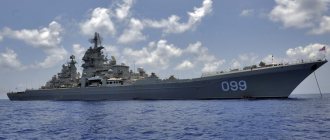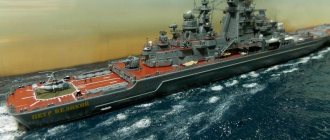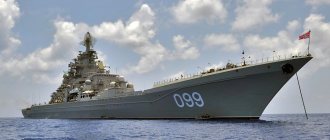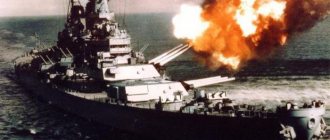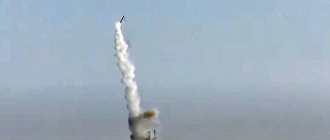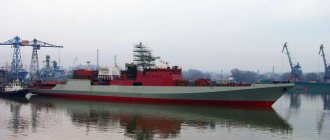3mv.ru
The size of a twenty-story building, a little more than 1/4 km long, the width of half a football field, weighing more than 25 tons, it reaches speeds of up to 59 km/h. This is all about it - the pride of the Russian Navy - the heavy nuclear-powered missile cruiser "Peter the Great".
Number one: “Peter the Great”
The largest ship in Russia is the nuclear-powered cruiser Peter the Great. Ships of this class appeared in the mid-60s of the last century. Due to the high cost and complexity of construction, only two superpowers – the USA and the USSR – could boast of having such cruisers in their navy. Today, there is only one nuclear-powered cruiser in operation in the world, the Pyotr Velikiy, which is part of the Russian Navy.
Ship history
Construction of the most powerful ship of the Russian Navy began in 1986. Three years later, the nuclear cruiser was launched. During development, the ship received the name “Yuri Andropov”, but in 1992 the ship was renamed. The tail number also changed - from 183 to 099.
Today, this heavy nuclear-powered cruiser is the largest non-aircraft-carrying ship in the world.
The construction and testing of the ship was approached with the utmost care. As soon as the cruiser was launched, it was sent for sea trials in the Arctic.
The ship has several interesting achievements:
- was the first to discover the wreck of the Kursk submarine;
- starred in films;
- detained several ships of Somali pirates;
- included in the list of the deadliest warships in the world.
“Peter the Great” is the flagship of the Russian Northern Fleet.
Characteristics of the largest ship
The combat strength of the ship is over a thousand people.
The largest Russian military ship has the following characteristics:
- 250 meters in length;
- 25 meters wide;
- almost 60 meters in height;
- displacement – up to 25 thousand tons;
- 60 days of autonomous navigation.
The power plant is represented by two nuclear reactors. This makes the powerful ship also one of the most dangerous in the world for the crew itself.
Interesting! Other countries, in particular the United States, have refused to use such cruisers, since if damaged, the ship poses a danger to its own crew.
The largest warship in the Russian fleet has a speed of about 32 knots, which is approximately 60 km/h. For comparison, the speed of a modern nuclear-powered aircraft carrier built two years ago in the United States is 30 knots.
History of creation
In 1964, the design of a domestic surface combat ship with an almost unlimited cruising range began. Initially, it was planned to create an 8,000-ton anti-submarine ship with a nuclear power plant. However, by the late 1960s, the US Navy's nuclear-powered intercontinental missile submarines entered the ocean and became virtually invulnerable. To combat them in order to prevent a nuclear strike, the Soviet Navy is creating operational formations of anti-submarine ships capable of maintaining combat duty in identified patrol areas of attack submarines of a potential enemy. In turn, ensuring the combat stability of shipborne anti-submarine groups required the creation of a larger multi-purpose cruiser, unlike the previously designed one. Thus was born Project 1144 heavy nuclear-powered missile cruiser.
TARKR "Peter the Great", the great-grandson of battleships and battlecruisers of the era of "armor and projectile", the last ship of Project 1144 "Orlan" is a further development of attack missile cruisers, including the cruiser of Project 1164. Unlike its predecessors, the TARKR has increased navigation autonomy and is equipped with more effective hydroacoustic means, anti-submarine weapons and cruise missiles. They have no analogues abroad: American cruisers with a nuclear power plant of the Virginia type are 2.5 times smaller in displacement, and the Long Beach cruiser is 1.5 times smaller. The creation of ships of this class became one of the most significant achievements of domestic shipbuilding of the 20th century.
Characteristics and equipment
The total displacement of the ship is more than 26,000 tons. Crew: 727 people. Flight personnel: 18 people. The main weapon is Granit anti-ship cruise missiles. Anti-aircraft, strike, and anti-submarine weapons allow the cruiser to solve almost any combat mission. The superstructures carry a variety of radars and antennas for early warning systems. The missile launchers are located forward, below deck, leaving the aft section for the main propulsion plant and helicopter hangar.
The main power plant is equipped with two fast neutron reactors with a thermal power of 300 MW each and two auxiliary oil steam boilers. Coupling nuclear reactors with oil superheaters increases the overall power of the installation and thereby the speed of the ship.
Two shafts rotate 2 five-blade propellers.
The technical complex of a nuclear power plant includes, in addition to the reactor, which converts nuclear decay energy into heat, a whole set of complex and critical technological equipment - pumps, steam generators, reactor and power plant control systems, a turbine with gearbox, filters, heat exchangers, compressors, various instruments and etc.
To ensure the operation of facilities with shipboard nuclear power plants, the following are additionally required: specially equipped bases with a number of coastal services, special means and devices for loading fresh and unloading spent nuclear fuel, collecting, storing and processing solid and liquid radioactive waste, etc.
Armament
The basis of the TARK's armament is the Granit P-700 (3M-45) anti-ship supersonic missile, which is a development of the Basalt anti-ship missile system. In the West, Granit missiles are known under the code name "Shipwreck". With a launch weight of 7 tons, the rocket develops a speed of 2.5 M and can deliver a high-explosive warhead weighing 750 kg or a nuclear charge with a power of up to 500 kt over a distance of 600 km.
The missile is designed to combat aircraft carrier strike groups (ACGs) and is capable of operating not only against formations of ships of all classes during armed conflicts of any intensity, but also to effectively hit targets on the enemy’s coast with a conventional warhead. If necessary, ships with the Granit complex can serve as a reserve for solving the tasks of the Naval Strategic Nuclear Forces. Initially, the Granit missile system was armed with 12 Project 949A nuclear-powered submarine cruisers of the Antey type, with 24 anti-ship missiles each, with a submerged speed of more than 30 knots.
On TARKR pr.1144, twenty Granit anti-ship missiles are installed under the upper deck, with an elevation angle of 60 degrees. The modification of the Granit anti-ship missile system installed on Project 1144.2 ships is not controlled after launch. In rapid fire mode, one missile, acting as a “gunner,” flies along a high trajectory to maximize the target acquisition area, while other missiles fly along a low trajectory. During flight, the missiles exchange information about targets. If a target missile is intercepted, then one of the other missiles automatically takes over its functions. The missile system is resistant to enemy radio interference.
According to the experience of combat and operational training of the Navy, it is almost impossible to shoot down such a missile. Even if you hit the Granit with an anti-missile missile, the missile, due to its enormous mass and speed, can maintain its initial flight speed and, as a result, reach the target.
TARKR ship combat systems include:
combat information center; radio communication system; satellite communication system; fire control systems for anti-ship missiles, RBU-1000 and Udav-1 complexes; radar stations: surveillance radar, radar for detecting low-flying and surface targets, fire control radar for ship air defense systems - 2 units, fire control radar for 30-mm gun mounts - 4 units, navigation radar - 2 units; as well as active, passive acoustic systems and electronic measurement systems.
The Perth the Great's anti-aircraft missile and artillery weapons include the S-300F air defense system, the Kinzhal air defense system, the Kortik air defense system with the AK-630 and the AK-130 artillery mount.
The Fort-M air defense system, unlike its predecessor, the Fort anti-aircraft complex, is capable of firing at up to 6 targets simultaneously at a distance of up to 120 km and successfully combating anti-ship missiles at altitudes of up to 10 meters. The expansion of the affected area was achieved by improving the energy characteristics of the transmitter and the sensitivity of the receiving channels.
The 48N6E2 anti-aircraft guided missile (unified with the S-300PMU-2 land complex) with a vertical launch has an improved propulsion system and an enlarged warhead. The missile is remote-controlled, with semi-active homing during the final flight phase. Delivered to the ship in a transport and launch container. The maximum flight range is 200 km.
On the cruiser “Peter the Great”, the S-300FM “Fort-M” bow complex was additionally installed. Thus, TARKR is armed with one S-300F complex with 48 48N6 missiles and one S-300FM complex with 46 48N6E2 missiles.
On the Peter the Great TARKR, instead of the Osa-MA anti-aircraft system installed on earlier ships of Project 1144 and on cruisers of Project 164, the Kinzhal complex with improved performance characteristics is installed. The Kinzhal air defense system is a multi-channel, all-submarine, autonomous close-in defense anti-aircraft missile system capable of repelling a massive attack of low-flying anti-ship, anti-radar missiles, guided and unguided bombs, airplanes, helicopters, etc. Adopted in 1989. large anti-submarine ships Project 1155. Of the heavy cruisers, the Kinzhal is also installed on the Admiral Kuznetsov. It is supplied abroad under the name “Blade”.
The Kinzhal air defense system can simultaneously fire at up to four targets in a spatial sector of 60° by 60°, while simultaneously targeting up to 8 missiles. The reaction time of the complex ranges from 8 to 24 seconds depending on the radar mode. The radar systems of the complex provide a detection range of air targets of 45 km at an altitude of 3.5 km.
The complex uses a remote-controlled anti-aircraft missile 9M330-2, unified with the missile of the land-based Tor complex, or the 9M331 missile defense system of the Tor-M complex. The launcher is below deck and consists of 4 drum-type launch modules, each containing 8 TPK with missiles. The weight of the module without missiles is 41.5 tons, the occupied area is 113 sq.m. The launch of the 9M330 rocket is vertical under the action of a catapult with further deflection of the rocket by the gas-dynamic system towards the target. The engine is started at a safe altitude for the ship after the rocket has descended.
The detonation of a high-explosive fragmentation warhead is carried out at the command of a pulse radio fuse in close proximity to the target. The radio fuse is noise-resistant and adapts when approaching the water surface. The missiles are placed in transport and launch containers and do not need to be checked for 10 years.
The Kinzhal system can operate autonomously or be integrated into ship fire control systems and receive target information from ship radars. In addition to the missile defense system, the fire control system of the Kinzhal complex can control the fire of 30-mm AK-360M assault rifles, completing the shooting of surviving targets at a distance of up to 200 meters.
The air defense armament of the cruiser "Peter the Great" was strengthened by the anti-aircraft missile and artillery complex ZM87 "Kortik" (later named "Kashtan"). The air defense system is designed to engage targets with missiles at a range from 8000 to 1500 m, and then finish off surviving targets with 30-mm AO-18 artillery guns at a distance from 1500 to 500 m.
The system provides self-defense against a number of “precision” weapons, including anti-ship and anti-radar missiles, aerial bombs, airplanes and helicopters, and small ships. The complex has a modular design, including 2 command modules and 6 combat modules. The command module identifies the threat and transmits information to the combat module, which accompanies the target, makes the necessary calculations and engages the target with missiles and cannons. The rate of fire of its guns reaches 10,000 rounds per minute. Ammunition 24,000 shells
Anti-aircraft missiles (ammunition load 192 missiles) are launched from a container launcher. The interception altitude is from 5 to 4000 m. The target can be hit at speeds of up to 600 m/sec. The system can hit up to six targets simultaneously, one target for each combat module
On the rotating part of the complex, two units (PU) of 3 missiles each are mounted, placed in cylindrical transport and launch containers weighing 60 kg. The 9M311K two-stage solid-fuel missile (later the letter “K” was removed from the index) is unified with the 2K22 Tunguska military air defense missile.
The missile control system is semi-automatic with a radio command line. The fuse is non-contact with a range of 5 meters. The 9M311 missile is the only domestic shipborne missile defense system with a fragmentation rod warhead. The length of the rods is about 600 mm, the diameter is 4-9 mm. On top of the rods there is a “shirt” containing ready-made fragments - cubes weighing 2-3 grams. When a warhead ruptures, the rods form something like a ring with a radius of 5 meters in a plane perpendicular to the axis of the missile. At a distance of more than 5 meters, the action of rods and fragments is ineffective.
The artillery unit consists of two 30mm six-barreled AK-630AD mounts with ballistics and ammunition (48,000 rounds). The total rate of fire is about 10,000 rounds/min. Unlike the AK-630, which are armed with muzzle caps on the barrel blocks to protect the installation and containers with missiles from powder gases. The ZM87 ammunition is not located in the turret, but in two drums of 500 rounds each, located next to the barrel blocks. The feeding of the machines is not belt, but auger (linkless).
Like other ships of projects 1164, 1144 TAVRK "Peter the Great" are equipped with 130-mm multi-purpose gun mounts (840 rounds). The system hits coastal, sea and air targets. The main components of the complex are: a computer-based control system with a multi-band radar, a television and optical aiming system, a two-gun turret 130-mm artillery mount equipped with a “Condensor” optical guidance device.
Loading is automatic and the guns can fire various projectiles with a contact fuse, a fuse that is triggered at the moment of maximum approach to the target, as well as training projectiles. The system is resistant to enemy interference. The guns can operate in a fully automatic control mode in conjunction with the radar, in an automatic mode with aiming using the Condenser aiming system installed on the turret, as well as in manual mode. the frequency of fire can vary from single shots to volley or burst fire. The fire range is over 22 km, and the rate of fire is 20-35 rounds per minute.
The cruiser's anti-submarine weapons are equipped with the Volgopad-NK anti-submarine missile system and the Udav-1 anti-torpedo system, RBU-1000 missile and bomb launchers and Ka-27PL helicopters.
The Volgopad-NK anti-submarine missile system has 20 anti-submarine missiles or torpedoes. Firing is carried out from 10 launchers (missile and torpedo tubes).
Udav-1 complex is equipped with 40 anti-submarine missiles. The Admiral Kuznetsov TAVKR has a similar system. RBU-1000 form the basis of the Smerch-3 system, which has the following composition: 2 six-tube remotely guided anti-submarine missile launchers RBU-1000 (ammunition capacity of 102 missiles), a loading device, RGB-10 depth charges with a UDV-60 fuse, a Burya PUSB system with “Buzzer” attachment, which controls the fire of up to four RBUs. The reaction time from the moment the submarine is detected until the start of shooting is 1-2 minutes. The range of the system is 1 km. Earlier models of attack cruisers (including Project 1164) have the Smerch-2 system with RBU-600.
Three Ka-27PL or Ka-25RT helicopters are also designed for anti-submarine defense. The Ka-27 is known in the West as “Helix” and is equipped with anti-submarine weapons, including search radar, sonobuoys, an acoustic system and magnetic anomaly detectors. The Ka-27 can be armed with torpedoes, bombs, mines and anti-ship missiles. The Ka-25, known in the West as the Hormone, is the predecessor of the Ka-27.
TARKR "Peter the Great" is the world's largest non-aircraft-carrying attack warship. “Peter the Great”, like other ships of the “Orlan” project, was designed as an attack cruiser to gain superiority at sea. And although the Project 1144 Orlan nuclear-powered cruisers have been the best ships of their class in the world for a number of years, a number of experts are forced to recognize the project as a failure. In their opinion, in order to withstand modern anti-ship missiles, aircraft cannons and small-caliber bombs, the ship should have been equipped with at least minimal armor protection. The ship does not have sufficient firepower and autonomy. The real "Orlan" can cope with any of the American post-war cruisers, but is absolutely defenseless against an aircraft carrier force or modernized American battleships of the LOWA type.
Maintaining it technically serviceable and combat-ready requires large investments. So, as noted above, recharging a nuclear power plant is a unique operation with a complex infrastructure that has not been created appropriately due to lack of funds.
Perhaps it is precisely such assessments that lead to the conclusion that the presence of Orlan class ships is not provided for in the development concept of the Russian Navy until 2015. The validity of such conclusions will be confirmed or refuted by history. At the same time, all possible negative consequences of the project’s implementation, with proper organization at the state level of the subsequent operation of the Peter the Great, can be significantly reduced, which in turn can provide favorable opportunities for the return to service of other ships of the Orlan project.
Missile cruiser “Moskva”
For the impeccable fulfillment of assigned tasks, he was awarded the Order of Nakhimov in 2016.
Another contender for the title of “the largest ship in the Russian Federation” is the missile cruiser “Moskva”.
This is one of the largest Russian warships, but the largest cruiser in Russia is still Peter the Great.
The length of this ship is almost 187 meters, the width is almost 21 meters. This ship was built by the Nikolaev Shipyard (Ukraine) in the late 80s of the last century, and is still in successful operation, but in 2022 it underwent major repairs. As part of the USSR it bore the name “Slava”, then it was renamed when it became part of the Russian Navy.
"Nakhimov" goes first
Aircraft-carrying cruiser "Admiral Kuznetsov"
The idea of re-equipping Project 1144 cruisers has been discussed for a long time, but money for it was allocated only under the State Armament Program for 2011–2020. The first ship was the Admiral Nakhimov (formerly Kalinin), which back in 1999 was delivered to the side of the Severodvinsk Sevmash with the wording “for repairs and modernization.”
Only in 2013, the Ministry of Defense paid Sevmash for a long project to inspect, repair and modernize the cruiser. In the fall of next year, the ship was moved to a loading basin in Severodvinsk and began to be examined. Initially, they wanted to return the cruiser to the fleet in 2018, but then the work was extended until the end of 2021.
The project, in addition to the actual restoration of readiness, includes a complete change in the composition of strike weapons: “Granit” is dismantled. In September 2013, Admiral Viktor Chirkov, who then held the post of Commander-in-Chief of the Navy, said that the cruiser would receive up to 80 missiles of various types, which allows us to conclude that 10 modules of the 3S14 universal ship-based firing system (UKSK, 8 cells each) will be installed on the Nakhimov. .
Cruiser_2
Heavy nuclear missile cruiser "Admiral Nakhimov". 1996
Photo: TASS/Semyon Maisterman
Missile cruisers "Peter the Great" and "Marshal Ustinov" went out for exercises in the Barents Sea
The 3S14 ammunition load includes 3M14 long-range cruise missiles, 3M55 Oniks and 3M54 anti-ship missiles, and anti-submarine missiles. Also, judging by press reports, the ship will also be equipped with new Zircon hypersonic cruise missiles, which are currently being tested. In terms of anti-aircraft weapons, the ship will receive the modernized S-300FM Fort-M complex (a similar one is installed on Peter the Great). Also, instead of the Dirks, new Pantsir-M air defense systems may be installed. The Poliment-Redut air defense system will also appear on the cruiser, although its testing on the lead frigate of Project 22350 Admiral Gorshkov has not yet been completed.
According to the same project, with minor changes related to differences in the composition of weapons and electronic weapons, the Petra will also be modernized. The fate of the Admiral Lazarev (Frunze), which has been suspended in the Pacific Fleet since the late 1990s, is still in limbo. Several attempts were made to scrap the ship, but at the last moment the decision was postponed. In 2014, the ship underwent dry dock repairs “to ensure unsinkability at the quay wall.” We can accurately conclude that based on the results of the completion of work on Nakhimov and the initial analysis of the condition of Lazarev, it will be clear whether it is worth contacting the third building. Most likely, the answer will be “no,” but it has not yet been officially given.
Russian Navy ships will remain in the Mediterranean Sea in 2022
But everything is already clear with the fourth ship, which is also the lead “Kirov”. The cruiser has not been at sea since 1991 (except for towing to Severodvinsk in 1999) and is in very poor condition. In 2015, a tender was held for a disposal project, after which the ship was to begin unloading spent nuclear fuel.
The real final cost of upgrading Nakhimov is unknown, but very substantial. So, in 2012, Anatoly Shlemov, then head of the state defense procurement department of the United Shipbuilding Corporation, estimated restoring the cruiser’s readiness at 30 billion rubles, and taking into account the installation of new weapons - up to 50 billion rubles. At that time, the planned cost of the Project 20380 corvette was 10 billion rubles, the Project 11356 frigate - 13 billion, and the Project 22350 frigate - 18 billion.
Cruiser_3
Heavy nuclear missile cruiser "Admiral Ushakov"
Photo: TASS/Andrey Babushkin
The submarine cruiser "Smolensk" conducted a training launch of a cruise missile
Let us note that these are estimated figures named before the conclusion of the contract and before the defect inspection, which determined the actual condition of the hull, general ship systems and cable routes. In addition, after 2014–2015, prices in shipbuilding began to rise sharply, as a result of which for a number of ongoing projects they rose by 60–70%. Thus, the rough estimate of the cost of re-equipping Nakhimov at 80–90 billion rubles no longer looks excessive.
This is quite an expensive pleasure, so the whole idea often attracts criticism from experts. With the money that will be spent on Nakhimov and Petra, at current prices it is possible to build 5-6 new frigates or a dozen corvettes. In addition, the fleet has a newer project in a similar weight category, which they have not yet been able to approach.
"Yury Dolgoruky"
The submarine is capable of diving to a depth of 450 meters and firing with the help of Bulava ballistic missiles, which it has in its arsenal. Having
figured out which cruiser is the largest in Russia, we should dwell on the characteristics of the largest submarine. This is the nuclear submarine “Yuri Dolgoruky”, the length of which is 170 meters.
K-535 “Yuri Dolgoruky” is part of the Red Banner Northern Fleet and is registered in the Murmansk region.
It entered service with the fleet in 1995 and is still in use today.
“Severodvinsk”
The Severodvinsk submarine, which is 120 meters long, can also compete for the title of the most powerful submarine of the Russian Navy or Navy.
The submarine K-560, or “Severodvinsk”, was launched in 2010 and serves as part of the Northern Fleet. It is interesting that this association of the Russian Navy is the youngest, but has several of the largest ships, including submarines.
The vessel's crew consists of 90 people; its special feature is its long navigation autonomy - up to 100 days.
